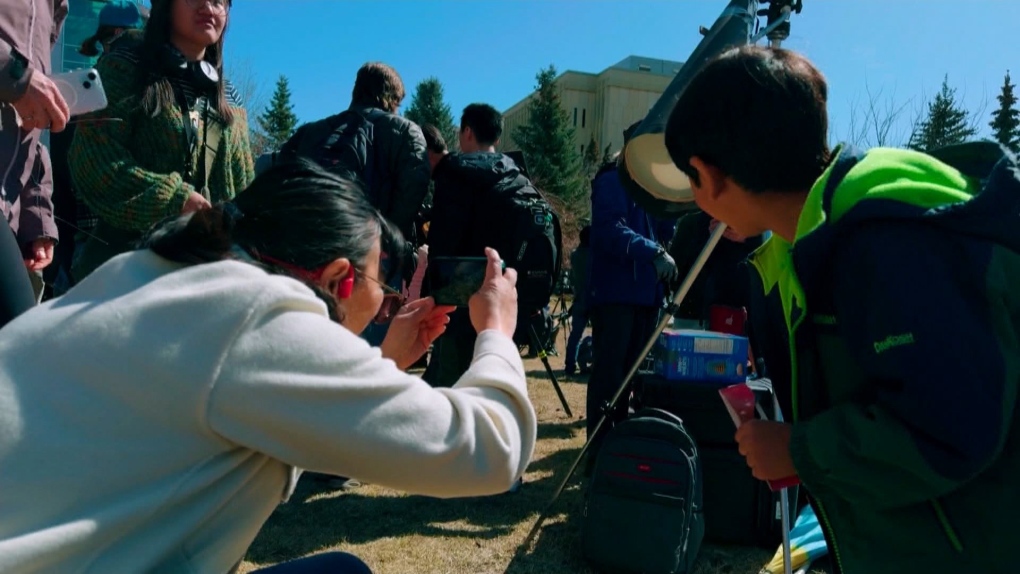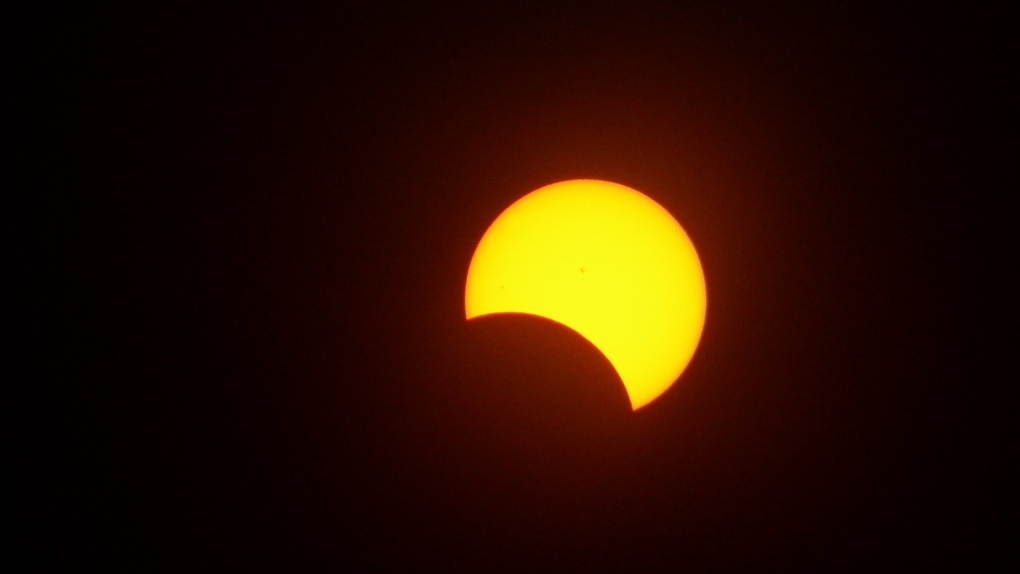'It does kind of put you in your place': Calgary comes out to catch glimpse of solar eclipse
Thousands of Calgarians flocked to the University of Calgary on Monday to get a glimpse of the solar eclipse.
While only about 40 per cent of the sun was covered in Calgary, it was still a special glimpse of the celestial dance going on every day, of which most of us are unaware.
Astronomers from the U of C's department of astrophysics, along with members of the Royal Astronomical Society (RASC), set up telescopes and viewing stations and distributed about 500 pairs of eclipse-safe glasses.
Damiloju Lawal was there with his mother and two sisters.
"When you think about it, how they are two very large celestial bodies and they kind of seem small from here but in reality, they are much bigger and grander I can probably imagine, it does kind of put you in your place," said Lawal.
"You realize that you are kind of this small being on this rock floating in the cosmos of space."
 Thousands of Calgarians flocked to the University of Calgary on Monday to get a glimpse of the solar eclipse.
Thousands of Calgarians flocked to the University of Calgary on Monday to get a glimpse of the solar eclipse.
Scientists value eclipses for their ability to provide insight into the workings of Earth's nearest star.
Despite being omnipresent in the daytime sky, there are still solar mysteries to be solved.
For U of C astronomer Jeroen Stil, that includes why the chromosphere, which is above the solar surface, is hotter than the layer below it.
"What we teach in astrophysics is that every layer further out in the sun is cooler than the layer below and that's how heat trickles out to the surface. But somewhere in the chromosphere, that trend changes and changes very rapidly," said Stil.
"Why that happens is actually still not well understood."
While Calgary only saw 40 per cent of the sun blocked by the moon, other portions of North America were in the path of totality.
The first landfall of the eclipse was on the west coast of Mexico.
Calgarian Mark Sikstrom headed to Mazatlan to catch it in all its glory.
"It is a once-in-a-lifetime experience," said Sikstrom.
"The difference between a partial eclipse and a full eclipse is the difference between a kiss on the cheek and a big hug."
 Mike Foreman took this picture of the partial solar eclipse from Springbank, in Rocky View County Alberta, on April 8, 2024. (Submitted: Mike Foreman)
Mike Foreman took this picture of the partial solar eclipse from Springbank, in Rocky View County Alberta, on April 8, 2024. (Submitted: Mike Foreman)
Calgarians who got that "kiss on the cheek" with Monday's partial eclipse but are looking for the "big hug" of a solar eclipse will have to wait.
The next solar eclipse is in 2026.
It's been dubbed the "Fire and Ice" eclipse because it is only visible on land from parts of northern Greenland, Iceland and portions of Spain.
For those able to wait a couple of decades, Calgary will be in the path of totality of a total solar eclipse in August of 2044.
CTVNews.ca Top Stories

Donald Trump says he urged Wayne Gretzky to run for prime minister in Christmas visit
U.S. president-elect Donald Trump says he told Canadian hockey legend Wayne Gretzky he should run for prime minister during a Christmas visit but adds that the athlete declined interest in politics.
Historical mysteries solved by science in 2024
This year, scientists were able to pull back the curtain on mysteries surrounding figures across history, both known and unknown, to reveal more about their unique stories.
King Charles III focuses Christmas message on healthcare workers in year marked by royal illnesses
King Charles III used his annual Christmas message Wednesday to hail the selflessness of those who have cared for him and the Princess of Wales this year, after both were diagnosed with cancer.
Mother-daughter duo pursuing university dreams at the same time
For one University of Windsor student, what is typically a chance to gain independence from her parents has become a chance to spend more time with her biggest cheerleader — her mom.
Thousands without power on Christmas as winds, rain continue in B.C. coastal areas
Thousands of people in British Columbia are without power on Christmas Day as ongoing rainfall and strong winds collapse power lines, disrupt travel and toss around holiday decorations.
Ho! Ho! HOLY that's cold! Montreal boogie boarder in Santa suit hits St. Lawrence waters
Montreal body surfer Carlos Hebert-Plante boogie boards all year round, and donned a Santa Claus suit to hit the water on Christmas Day in -14 degree Celsius weather.
Canadian activist accuses Hong Kong of meddling, but is proud of reward for arrest
A Vancouver-based activist is accusing Hong Kong authorities of meddling in Canada’s internal affairs after police in the Chinese territory issued a warrant for his arrest.
New York taxi driver hits 6 pedestrians, 3 taken to hospital, police say
A taxicab hit six pedestrians in midtown Manhattan on Wednesday, police said, with three people — including a 9-year-old boy — transported to hospitals for their injuries.
Azerbaijani airliner crashes in Kazakhstan, killing 38 with 29 survivors, officials say
An Azerbaijani airliner with 67 people onboard crashed Wednesday near the Kazakhstani city of Aktau, killing 38 people and leaving 29 survivors, a Kazakh official said.






























